Part 1
Lya Li: Lord of the Flies — The tragic flow of creation, dominance, insanity, and destruction.
Inspired by the famous eponymous novel, Lord of the Flies is an artwork designed for explorers to experience the process of a mysterious creature’s life and death. The theme of greed and pride is discussed when explorers “communicate” with the creature in this visual project.
Despite being discovered 80 years ago, this is a creature that no scientist had successfully experimented on because it seemed to have a mysterious power to control all nearby creatures’ minds. Fortunately, it hasn’t become a threat to mankind because somehow it could never escape its fate of destruction. Explorers will witness its limitless will to gain power and control others and its tragic ending of being eaten by its own power. This process proves that if one gains more power than its capability to manage it, the power would eventually lose control and cause the loss of sanity.
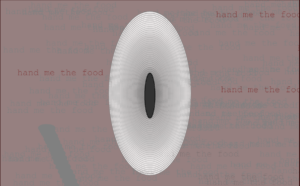
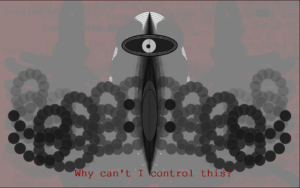
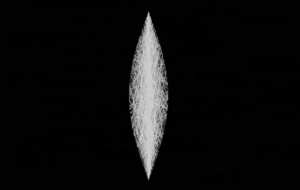
the beginning of life losing control with great power destruction and silence
Part 2
- Process: Design and Composition
I came up with all the narrative ideas above after I did my exploration of combining different movements in a recitation task. I was trying to combine oscillation and the noise function when I noticed that the pattern it drew looked like the wings of moths, so I decided to create a moth-like creature.
I then started to consider adding stories and a name for the moth. In a very straightforward way, I recalled the title of the famous novel: Lord of the Flies. This novel is about a group of kids who started to dominate themselves after surviving a plane crash on an island. Some of them got the power to give orders to others, yet they themselves didn’t have the ability to appropriately use it. So the teenagers that were innocent before couldn’t stop behaving chaotically and violently until adults—bigger authority—came to rescue them. I think it would be pretty interesting to show the process of power alienating people in this project, so I used this as my conceptual inspiration.
For the visual effects, I am very obsessed with the visual effects ovals and oscillations create, and I also think it would be interesting to add some crazy elements to my project with randomness and noise, so the result is basically the combination of these two kinds of movements.
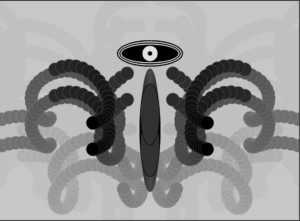
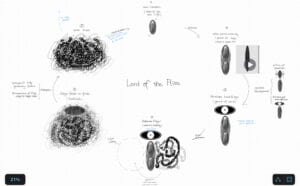
2. Process: Technical
What takes me most time is dividing the whole life process into different stages. To achieve this, I defined 5 functions with each of them tracing different mouse interactions or time changes. Then in the draw() function, I set different conditionals to decide which function the program should call. However, I really think that this could be improved by splitting the whole project by the components instead of time and interactions because there are so many components that appear in more than one stage and therefore it creates so many repetitions in my code. I actually tried to redo the project by splitting it into different components and using another function to detect the stages, but I don’t have enough time to finish it 🙁
I spent some time adding details in the interactions related to feeding the creature. I wanted to detect whether the explorers successfully picked and dropped the food in the right place and I thought my code worked, but I tested it later and it turned out that there were so many ways the explorers could escape the conditionals. I guess it is related to the booleans I used, but also I actually should ask my professor or LAs for help on this.
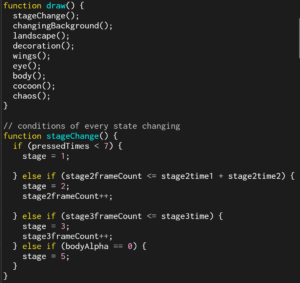
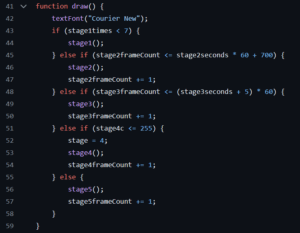
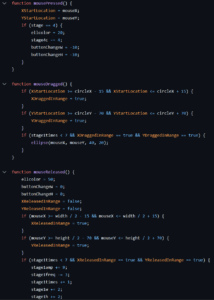
3. Reflection and Future Development
Sadly, I did not have the chance to complete my idea of making a loop life circle for the creature. The narrative would be much more complete if the creature would go back to the single cell after the chaos it creates because symmetrically the process of greedily getting too much power and eventually becoming insane also happens over and over again in real life. But it does have some improvements though, as it has more interactions and is more engaging with the explorers. The interaction part wasn’t in my plan before as I never thought of it, but after this, I would always keep this in mind because it is indeed an essential part of any artwork. I also added some textual elements to express my ideas better and communicate with my explorers. However, I’m still not sure whether a good work should use “subtitles” like this because I was worried that this means my project was not self-explanatory enough.
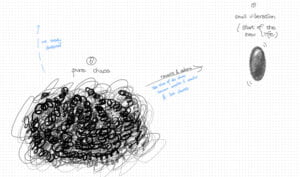
I really like the ideas of the instructors and classmates about how to improve the interactions and playthrough experience. I added food for explorers to feed and made its eye follow the cursor according to their ideas. It is surprising, though, that both the instructors and classmates found it interesting to add more narratives and explanations to this project. They also suggested I let explorers decide whether to feed the creature and make a multi-ending for it, which I feel could be a good motivation that encourages the explorer to really walk through the whole theme. I think this kind of motivation is the thing I would work on in my further work because it challenges me to go through all the ways that might help me explain my ideas better with my work itself.
4. Credits & References
Most importantly, the novel Lord of the Flies by William Golding (LordoftheFlies.pdf (lexiconic.net)) gave me conceptual inspiration for the plots and narrative. Professor Moon has been very supportive of my ideas and has given me confidence in it. I kind of worked on this all on my own in this project when actually doing all the coding work, but I think I should seek more help in future projects to broaden my sight and make the outcomes better.